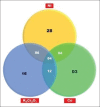Allergens in Hand, Foot, and Hand-Foot Eczema: An Intercomparison by Patch Testing
- PMID: 34446964
- PMCID: PMC8375524
- DOI: 10.4103/ijd.IJD_549_16
Allergens in Hand, Foot, and Hand-Foot Eczema: An Intercomparison by Patch Testing
Abstract
Background: Hand eczema (HE), foot eczema (FE), and hand-foot eczema (HFE) manifest on exposure to various agents in day-to-day life or in occupations or both.
Objectives: The objectives of this study were to identify pattern of allergens causing HE, FE, and HFE and to identify multiple and concurrent contact allergies.
Materials and methods: A study was conducted from October 2013 to August 2015 which included 190 patients. Patch test was performed for 78.94% of patients (n = 150). The statistical tests used were descriptive, Cramer's V, and Chi-square tests.
Results: The most commonly affected group was HFE (55.8%) followed by HE (22.1%) and FE (22.1%). Allergens showed positivity either singly 56.3% (n = 67) or in combination 43.69% (n = 52). Nickel (41.79%) was the most common allergen in all the three groups followed by potassium dichromate. Late reactions (after day 7) were observed in 17.64% of patients (n = 21). Nickel was observed in 42.85% (n = 9) and paraphenylenediamine was observed in 28.57% of patients (n = 6) with P values of <0.001 and 0.050, respectively. Multiple contact allergies were seen in 44% of patients (n = 52). Concurrent reactions (55.8% [n = 29]), polysensitization (34.6% [n = 18]), and mixed reactions (9.6% [n = 5]) (P value of <0.001) were observed.
Conclusion: Significant multiple contact allergies including concurrent reactions with nickel sulfate, potassium dichromate, cobalt chloride, and polysensitization were observed. No significant differences in allergen pattern were observed in HE, FE, and HFE.
Recommendation: Day 7 reading is recommended in HFE.
Keywords: Allergic contact dermatitis; hand–foot eczema; patch testing.
Copyright: © 2021 Indian Journal of Dermatology.
Conflict of interest statement
There are no conflicts of interest.
Figures
References
-
- Thyssen JP, Johansen JD, Linneberg A, Menné T. The epidemiology of hand eczema in the general population – Prevalence and main findings. Contact Dermatitis. 2010;62:75–87. - PubMed
-
- Kishore NB, Belliappa AD, Shetty NJ, Sukumar D, Ravi S. Hand eczema – Clinical patterns and role of patch testing. Indian J Dermatol Venereol Leprol. 2005;71:207–8. - PubMed
-
- Skoet R, Olsen J, Mathiesen B, Iversen L, Johansen JD, Agner T, et al. A survey of occupational hand eczema in Denmark. Contact Dermatitis. 2004;51:159–66. - PubMed
-
- Toledo F, García-Bravo B, Fernández-Redondo V, De la Cuadra J, Giménez-Arnau AM, Borrego L, et al. Patch testing in children with hand eczema.A 5-year multicentre study in Spain. Contact Dermatitis. 2011;65:213–9. - PubMed
-
- Landeck L, Uter W, John SM. Patch test characteristics of patients referred for suspected contact allergy of the feet – Retrospective 10-year cross-sectional study of the IVDK data. Contact Dermatitis. 2012;66:271–8. - PubMed
LinkOut - more resources
Full Text Sources





